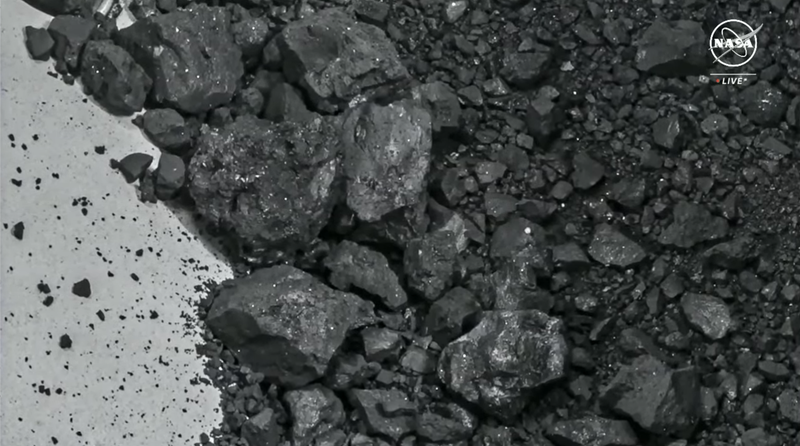The OSIRIS-REx canister still contains the bulk of the asteroid sample inside, but pieces of the ancient space rock found on the outside have already shown evidence of organic matter embedded within tiny bits of debris.
On Wednesday, NASA revealed the first look at samples returned from asteroid Bennu through its OSIRIS-REx mission. Scientists performed an early analysis of the asteroid sample and found an abundance of carbon and water molecules, supporting the theory that the building blocks of life may have made their way to Earth via asteroids.
“This is the biggest carbon-rich asteroid sample returned to Earth,” NASA Administrator Bill Nelson said during the event at the Johnson Space Center in Houston. “Carbon and water molecules are exactly the kinds of material that we wanted to find, crucial elements in the formation of our own planet and they’re going to help us determine the origin of elements that could have led to life.”

The samples was dropped off to Earth in late September, performing a parachute-assisted landing in the Utah desert after traveling through space for nearly three years. A curation team has been carefully disassembling the TAGSAM (Touch-and-Go Sample Acquisition Mechanism) head to get to the bulk of the sample.
Although they haven’t even opened the sample canister yet, extra bits of the asteroid were found outside TAGSAM—an articulated arm on the spacecraft with a round sampler head at the end used to grab the sample. The entire sample far exceeded NASA’s goal of collecting 60 grams from the surface of Bennu. What’s been revealed so far from the bonus sample is “a combination of fine dust, as well as some of what we call intermediate sized particles,” Nicole Lunning, OSIRIS-REx Lead Curator, said on Wednesday.
In order to fully preserve the asteroid debris on the outside, it’s taking the team more time to open the canister. “The only problem is a great problem and that’s we’ve found a lot more sample than we’re anticipating before even getting into the TAGSAM,” Daniel Glavin, OSIRIS-REx Sample Analyst, said at the event. “Because we need to very meticulously and carefully collect every grain, it’s taking us a little longer to get inside, but the view so far is amazing.”
Over the past two weeks, the team has been analyzing some of the bonus sample using an electron microscope, infrared measurements, X-ray diffraction, and chemical element analysis. The collected sample so far is 4.7% carbon by weight, making it the highest abundance of carbon ever measured in an extraterrestrial sample, according to Glavin. It also contains abundant water in the form of hydrated clay minerals.
“We picked the right asteroid,” Glavin said. “And not only that, we also picked the right sample—this is an astrobiologist’s dream.”
Bennu is a small, near-Earth asteroid that makes a close pass to Earth every six years or so. Scientists believe Bennu might have broken off from a much larger carbon-rich asteroid about 700 million to 2 billion years ago and drifted much closer to Earth since then. Analyzing bits of the asteroid in a lab will help scientists piece together clues on the origins of the solar system. Bennu is also a near-Earth potentially hazardous asteroid, therefore studying it closely can help us learn more about its potential threats to our planet.
The OSIRIS-REx mission launched in September 2016 and reached asteroid Bennu in December 2018. After nearly two years of observations, the spacecraft landed on Bennu and snagged a sample from its surface in October 2020. On May 10, 2021, OSIRIS-REx said goodbye to Bennu and began its journey back home to drop off its precious cargo.
Once the samples touched down on Earth, the work on the ground was only just beginning. The sample analysis team is made up of 230 scientists around the world, and returned pieces of the asteroid will be allocated to different teams to perform in-depth analysis of Bennu’s composition. NASA will keep at least 70% of the sample at Johnson Space Center for future research to take place decades from now, hoping to take advantage of advanced technology in the coming years.
Some of the asteroid bits will also be made available for public display at the Smithsonian Institution, Space Center Houston, and the University of Arizona.
